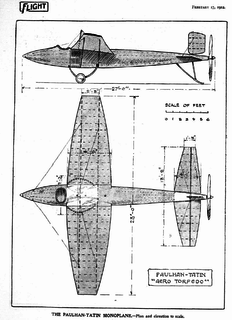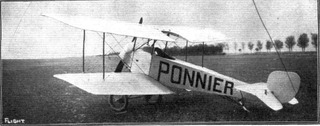Related Research Articles

The Aero A.38 was a Czechoslovakian biplane airliner of the 1920s and 1930s. Following the relatively modern A.35, this aircraft was something of a throwback, marrying a fuselage derived from the A.35 to wings copied from the A.23. A few served with CSA, and others with French airline Compagnie Internationale de Navigation Aérienne. These latter aircraft were powered by a French Gnome-Rhône engine instead.
The Arsenal O.101 was a French research aircraft that flew shortly after World War II. It was a low-wing monoplane of conventional configuration with fixed tailwheel undercarriage, but incorporated several novel features for its role as an airborne testbed for evaluating airfoil sections and control surface designs. It was designed to accommodate a pilot and an observer in tandem cockpits. However, since the observer was to be watching the aircraft's wings, this cockpit was sunken fully into the fuselage, affording no fore-and-aft view at all. The pilot's cockpit was set well back along the fuselage, near the tail.

The Morane-Borel monoplane was an early French single-engine, single-seat aircraft. It was flown in several European air races.

The Borel military monoplane was a French single-engine, two-seat aircraft designed shortly before World War I in response to a French Army requirement for an aircraft to seek and destroy enemy balloon airships.

The Bristol Gordon England biplanes were a series of early British military biplane aircraft designed by Eric Gordon England for the Bristol Aeroplane Company that first flew in 1912. Designed for easy ground transport, the aircraft could be quickly disassembled.
The Fauvel AV.50 Lutin was a design for an unorthodox light aircraft produced in France in the 1970s. Like some other Charles Fauvel designs, it was a tailless aircraft with a reverse-delta wing. In this case, it was a single-seater intended to be powered by a converted Volkswagen engine. Only one example was known to have been under construction by 1977, in Australia.

The Sagem Crecerelle ("Kestrel") is a reconnaissance UAV developed in France in the 1990s, based on the Meggitt Banshee target drone. Its configuration is much like that of the Banshee, with a pusher prop, a clipped delta wing, and a single tailfin, though its fuselage is more cylindrical. It is powered by a 20 kW (26 hp) rotary engine and has no landing gear, being recovered by parachute and airbags. The Crecerelle saw action with French forces during the Kosovo campaign in 1999. Meggitt sells much the same machine as the Spectre.
The Pottier P.100 and its derivatives were a family of single-engine aircraft developed in France in the 1970s and 80s. They were high-wing cantilever monoplanes of conventional design with enclosed cabins and fixed tricycle undercarriage. The P.100 had two seats, arranged side-by-side, while the P.110 had its fuselage stretched by 50 cm (20 in) to include a third seat and a greater wingspan. The P.105 was a hybrid of the two designs, featuring the shorter, two-seat fuselage of the P.100 and the longer-span wings of the P.110.

The Dalotel DM-165 was a French two-seat training monoplane designed by Michel Dalotel. A number of variants were proposed but only the prototype was built.
The SPAD S.G1 and SPAD S.G2 were French single seat tractor biplanes of ca 1915/16, following similar arrangements to the SPAD S.A2 family with the propeller and engine buried in the fuselage and a pod suspended in front of the engine. A single SPAD S.A-1 was converted with a small circular section pulpit nacelle mounting a mock-up of a fixed forward-firing machine-gun and smaller wings.
The Borel Bo.11 was a French two-seat general purpose monoplane designed and built by Etablissements Borel.

The Heinkel He 71 was a German single-seat monoplane, a smaller version of the two-seat Heinkel He 64. A low-wing monoplane with a fixed conventional landing gear, the prototype first flew with an open cockpit and a 60 hp (45 kW) Hirth HM 60 engine. It was later modified with an enclosed cabin and a 78 hp (58 kW) Hirth HM 4 engine. With additional fuel tanks to increase range it was used by German aviator Elly Beinhorn on a flight around Africa.

The Paulhan-Tatin Aéro-Torpille No.1,, was a French experimental aircraft built in 1911 as a collaboration between the famous pilot Louis Paulhan and Victor Tatin, a scientist who had experimented with various types of flying models and in 1879 had made the first model aircraft to take off under its own power.

The Ponnier L.1 was an early French biplane single seat scout, built just before World War I. It did not reach production.

The Hanriot D.I was a French monoplane racing aircraft, designed in France in 1912 and strongly influenced by Nieuport practice. Examples were built and raced both in France and the UK during 1912.

The Caudron Types M and N were small, fast French sports monoplanes, flown 1911–13 under a wide range of engine powers. There was also a military version.
The Rossel-Peugeot monoplane was a French experimental aircraft built in the early 1910s.
The Réquillard 1910 monoplane was a French experimental monoplane aircraft built in the early 1910s.
The Pivot-Koechlin monoplane was a French experimental monoplane aircraft built in the early 1910s.
The SP-18 Onça also known as the IPAI-27 Jipe Voador, was a Brazilian single-seat, single engined experimental agricultural aircraft.
References
- Taylor, Michael J. H. (1989). Jane's Encyclopedia of Aviation. London: Studio Editions. p. 193.
- Gunston, Bill (1993). World Encyclopedia of Aircraft Manufacturers. Annapolis: Naval Institute Press. p. 54.
- Contemporary diagram published in l'Aérophile, date unknown